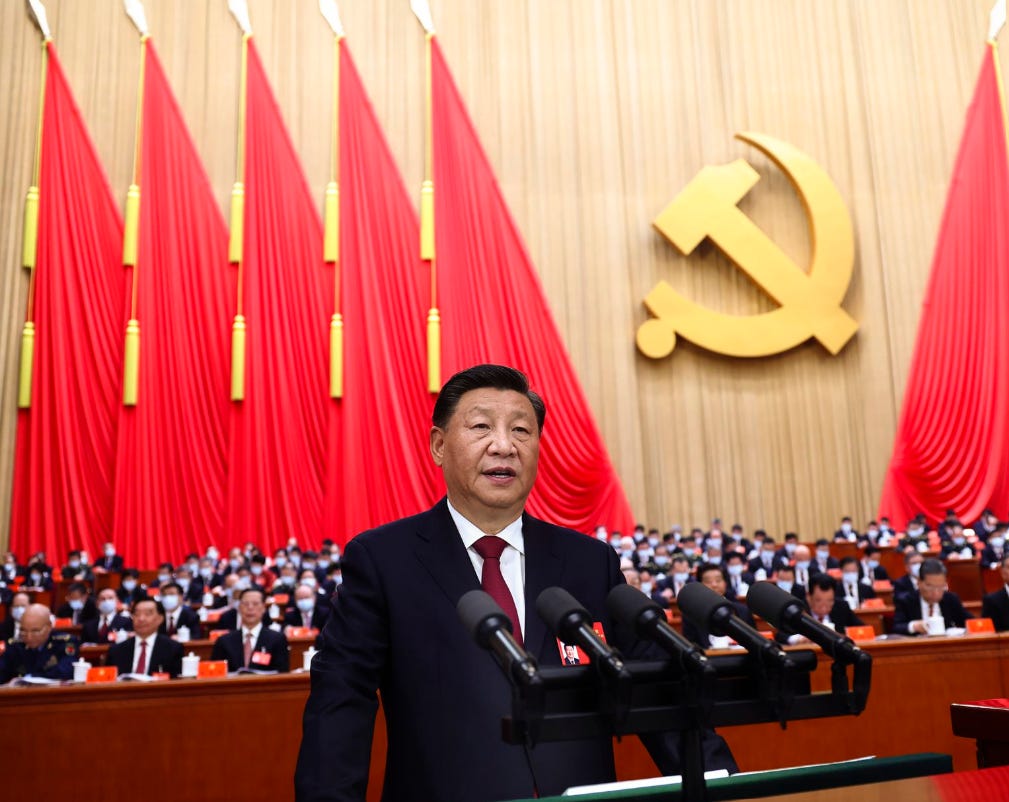
Xi Jinping and Chinese Communist Party functionaries
This continuing series is examining communist China’s various strategic initiatives and lesser schemes that together aim to rejuvenate the Chinese economy, promote Chinese leadership in virtually every sphere of human endeavor, and aim to supplant the US as the only global superpower while persuading the world of the “inevitability” of China’s ascendance to world leadership in all things.
The first part of this series focused on the Belt-Road Initiative – the flagship program aimed at developing a global manufacturing infrastructure centered in mainland China with a sea and land transportation network that will expedite the inward flow to China of raw materials needed for Chinese industry and the outward flow of finished goods and products to overseas markets.
The second part described other initiatives using the belt-road metaphor, including the Arctic Silk Road (北極 絲綢之路), the Space Silk Road (太空丝绸之路), the Health Silk Road (健康丝绸之路), and the Digital Silk Road (数字丝绸之路).
This part examines the Made in China 2025 initiative and several other complementary initiatives that are intended to promote economic self-sufficiency and insulate China from external economic pressures.
MADE IN CHINA 2025
Announced by Xi Jinping in 2015 to address the manufacturing hub component of the BRI, the purpose of the Made in China 2025 initiative was to implement modern Chinese-developed technology and networks to reduce dependence on foreign technology and to promote Chinese technological manufacturers and exports throughout the world. A key goal is to build out a complete industrial supply chain intended to make whatever China needs with minimal foreign dependencies.
The initiative focused on ten priority sectors: new generation information technology, advanced numerical control machine tools and robotics, aerospace technology, including aircraft engines and airborne equipment, biopharmaceuticals, high-performance medical equipment, electrical equipment, farming machines, railway equipment, energy-saving and new energy vehicles, and ocean engineering.
Incorporating advanced technologies from these sectors into Chinese manufacturing processes would put China on a par with other countries in terms of quality and cost and lead to an explosion of exports, with an eventual goal of making China the leading manufacturing hub of the world.
The initiative incorporated several interlinked strategies to achieve its ends:
- Joint ventures with foreign companies that facilitated tech transfer to wholly-owned Chinese enterprises over time.
- Solicitation of massive foreign direct investments (with the carrot of “accessing the gigantic Chinese domestic market”)
- Joint research projects with foreign universities and laboratories (and the resultant technology and intellectual property transfer to China)
- Massively state-subsidized indigenous research and development and applied technology implementation (including reengineering foreign technology components to suit Chinese needs)
- Industrial espionage to bypass R&D costs and obtain what could not otherwise be obtained through normal development processes
Emily de La Bruyère, a senior fellow at the Foundation for Defense of Democracies, testified about Made in China 2025 before the U.S.-China Economic and Security Review Commission on 6 February. She stated that “China uses its industrial capacity to project power… for strategic ends, to tie foreign incentives to China’s own — and, ultimately, to shape global markets, politics, information, technology, in a self-reinforcing fashion.” She further notes that, if China achieves the goals of Made in China 2025, “the U.S. industrial and defense industrial bases will find themselves entirely dependent on China.” This is the threat to the US that cannot be left unchallenged.
According to the South China Morning Post last April, China has achieved 86% of the targets set by Made in China 2025, not to mention considerable Chinese manufacturing overcapacity that has led to an enormous trade surplus with the US in recent years (and other nations, too!). That said, there are a number of countermeasures being implemented by the US and other countries that address the trade deficits that have developed as China has become the top exporting country in the world in 2024. These countermeasures include:
- Revocation of China’s Permanent Normal Trade Relations (PNTR) status
- Re-establishment of the infrastructure necessary for US domestic industry growth, especially a permissive regulatory environment
- Implementation of tariffs to shelter and grow domestic industries
- Reduction of FDI to China
- Relocation of factories to other countries
- President Trump’s newly-announced “Fair and Reciprocal Plan” for rebalancing trade with all countries, but especially China
- Increased efforts to shut down and prosecute Chinese industrial espionage and theft of intellectual property
- Exploration and mining of rare earth elements aimed at breaking the Chinese strangle hold on these strategic materials
- Coordinated diplomatic pressure on Beijing in response to Chinese mercantilism that violates World Trade Organization principles
OTHER INITIATIVES LINKED TO MADE IN CHINA 2025
Intricately linked with Made in China 2025 is the Digital Silk Road that was described in part one of this series. Its goal is to create a spatial digital information system through the seamless integration of telecommunications networks, artificial intelligence capabilities, cloud computing, e-commerce and mobile payment systems, surveillance technology, smart cities, and other high-tech components. The success of that effort is dependent on China’s ability to set the rules and standards by which these technologies will be developed and integrated.
That is precisely the objective of the China Standards 2035 initiative, which seeks to gain control of the international standards certification process by replacing the International Organization for Standardization (ISO) with a Chinese standards convention built around key Chinese-developed technologies from Huawei, Tencent, Alibaba, Bytedance, and other top technology companies. Control the standards; control future technology development, integration, and deployment/usage. These are some of the technologies that China seeks to dominate if not control outright: 5G, artificial intelligence, mobile payment systems, blockchain/digital currency, search engines (Baidou), social e-commerce, and many others that will define the new digital economy around the world.
A key US and allied countermeasure to the adoption of Chinese technology standards involves educating potential adopters to the potential for Chinese cyberespionage, the loss of data privacy, and sabotage of critical infrastructure. These concerns have led to US bans on the use of key Chinese technologies provided by, for example, Huawei and ZTE, in critical infrastructure systems. Another countermeasure is the continued acceptance and modernization of the ISO standards used by most of the industrial world.
CONCLUDING THOUGHTS
China’s long-term intentions are clear: to elevate Beijing to global leadership by leaping ahead of the US economy through any and all possible means, including industrial espionage and mercantilism. Made in China 2025 is intended to insulate the Chinese economy from foreign pressures while building a next-generation economy that incorporates advanced technologies. US and allied countermeasures are underway, but are they enough to thwart China’s goals?
The next part of the series will discuss China’s so-called “global initiatives” and the new Chinese world order that will result if the CCP is successful in achieving their goals.
The end.




